As an avid gardener, you know that natural light is crucial to the growth of your plants. But what do you do if you live in an area with limited daylight (low light) or have a short growing season? Artificial sunlight can help you optimize your results and give you more control over your growing environment, especially when we have lower light in the winter months.
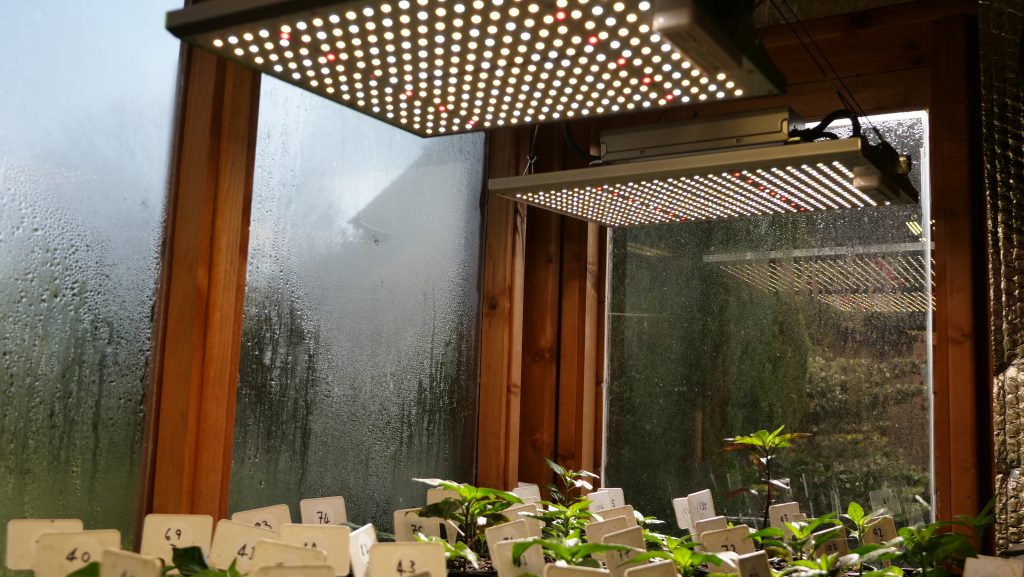
If you have a limited growing season, you’re short on outdoor space and grow plants indoors, or you want more control over your growing environment, artificial grow lamps can help you to maximize results. This article covers all aspects of artificial grow lamps to ensure you provide for your plants well.
Explore this Topic
Artificial Lights for Plants – Does a Chili Pepper Plant Grow Better?
Artificial grow lights are an excellent source of supplemental light and can help boost the early growth of your indoor plants, such as chilies, tropical plants, and other crops. Using a sunny windowsill has some benefits in the spring, but in the winter months, the amount of light from the sun and the intensity of light are insufficient to support early germination and growth. The further you live from the equator, the shallower the sun’s angle, reducing the power of the bright light, so it’s all about location, location, location. That’s where artificial grow lights are ideal.
Crops like chilies and tomatoes are plants that require a long growing season and many hours of light. Getting a decent harvest when you live in areas with short seasons or limited daylight can be challenging. If this is an issue, providing your small plants with artificial sunlight for plants can be an excellent solution to help your plants grow and flower and, of course, bear fruit.
A significant benefit of growing plants indoors with artificial light is that artificial light may be used anywhere you have electricity. Most people will use them in the home as lights for houseplants or a greenhouse. You may have a small corner in the shed or garage you want to use. And adding artificial light can help you utilize the space to grow your fruit, vegetables, and indoor houseplants. I’ve set up artificial grow lamps in my potting shed, which gives me much more control over the growing conditions for my chilies. It’s a much smaller space than my greenhouses. I can manage the extra light downward and temperatures at this critical stage for my smaller plants.
Grow lights can also extend your growing season. If, like me, you’re keen to become as self-sufficient as possible, you can use grow lights to grow salad and vegetables all year round.
Artificial Lights for Plants – When Should I Start Using Grow Lights?
You don’t need to use grow lights as soon as you’ve planted your seeds. As long as the soil is warm, your seeds will get the energy they need to germinate. However, as soon as your seedlings sprout, turn on your grow lights to provide light to the plants that need it.
Once seedlings have emerged from the soil, which is an exciting time for any gardener, they’ll start looking for light. If the light isn’t readily available, your seedlings can reach for any light available and get leggy. You want to ensure your plant grows robust, and they’ll do well under artificial lights typically.
With artificial grow lights, you’ll provide the light necessary for plant seedlings to grow strong and healthy. You want to give your seedlings the best start to life and reduce their risk of dying. I find it so upsetting to throw away any plants, so I do everything I can to ensure they begin life as sturdy seedlings.
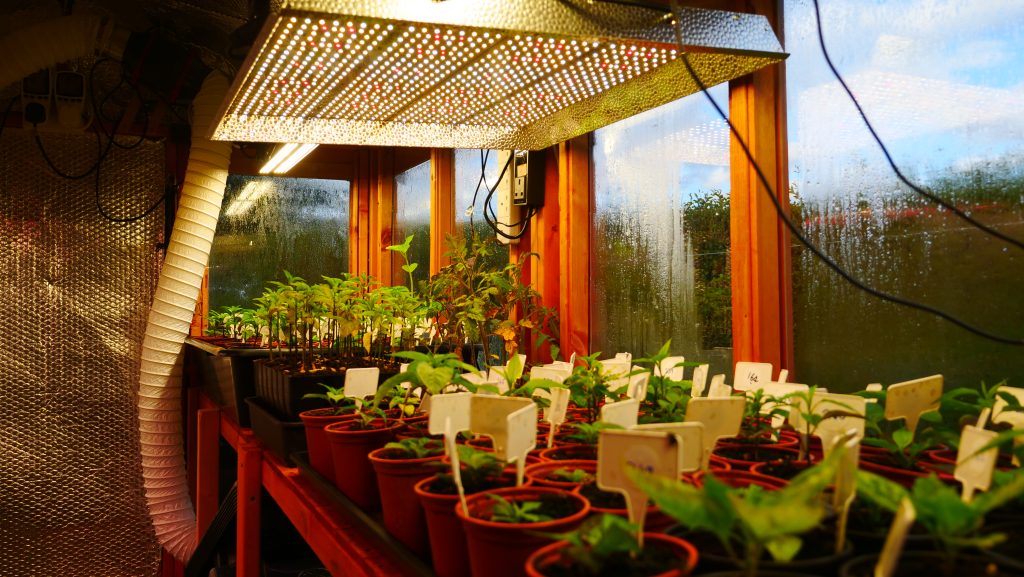
If your seeds haven’t germinated within a few days of planting, you may want to add artificial light sources to be safe. You don’t want to miss the first shoots breaking through the soil.
I’ve been growing chilies and other crops for many years, and I’ve tried many methods to get the best results. I swear by artificial grow lights. When I transplant my chilies, I want to ensure they can grow into vigorous, healthy, highly productive plants. And, of course, these days, my livelihood depends on it!
Artificial Lights for Plants – How Much Light Does My Chili Pepper Plant Need?
You’re trying to replicate a summer day by providing plants with artificial lights. Your plants require about 12 to 14 hours of artificial light daily and some supplemental natural sunlight. If they have no natural light, you may need to make artificial light available for 14 to 16 hours.
The amount of light needed by your plants varies depending on the growth stage and other environmental factors. Daily Light Integral (DLI) is the total light a plant receives in 24 hours, measured in moles per meter squared daily. How much light is typically absorbed by a plant in 24 hours depends on plant age, health, temperature, humidity, and CO2 levels. More detail on the exact light dose your plants need can be found below, so be sure to keep reading.
Grow lights are manufactured to focus on a small part of the ideal light spectrum. Artificial lights are highly optimized to be effective during critical growing stages, such as in vegetative growth and flowering/fruiting.
Understanding that humans and plants process light differently when selecting artificial grow lights is essential! Human eyes are sensitive to yellow and green light, whereas plants are sensitive across the entire light spectrum. Because we process light differently from plants, lights that appear bright and intense to us are often medium light intensity at a push, but mainly low light intensity for plants.
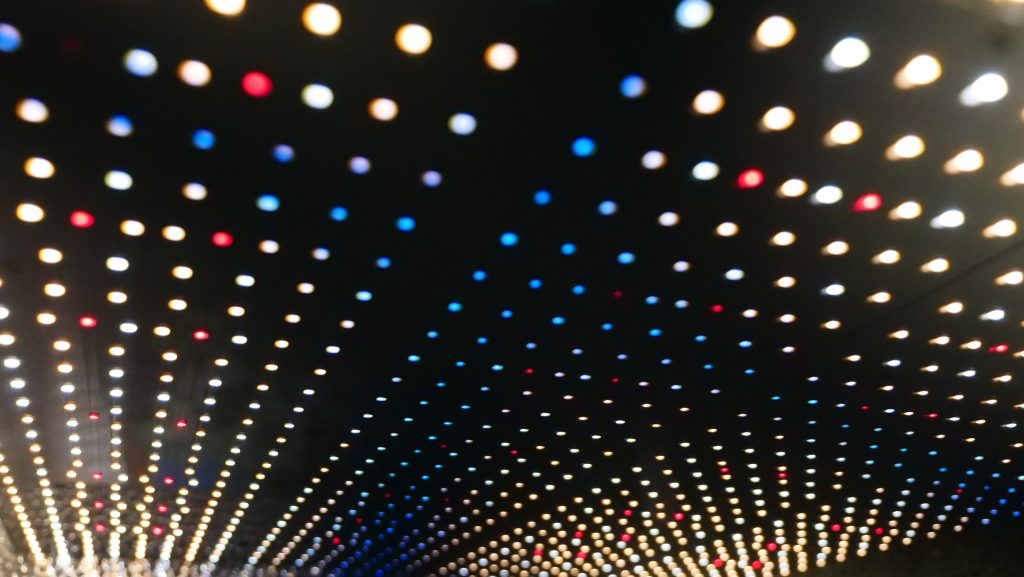
As discussed above – if you have a good amount of outdoor space, you do not need to use grow lights for the entire season. It would be best to have them once your seeds sprout and until the weather improves enough for you to transplant them outdoors or into a greenhouse.
Artificial Lights for Plants – What is the Best Plant Lighting to Use?
The best lights are used in horticulture to keep plants thriving and to get the best results when growing crops. There are many different types of artificial light available. Fluorescent bulbs and LED lights offer the most effective light intensity and are designed to be more efficient lights for indoor use.
To let you know, fluorescent lights are great for early-stage growth but may only be up to the task for part of the growing season. They are my favorite types of lights to use for young seedlings!
The best lights for horticulture are fluorescent lights and LEDs. Fluorescent lights are great for early-stage growth but may only be up to the task for part of the growing season. LEDs are more efficient than fluorescents and offer more control over the intensity of light throughout the growing season. They’ve also become more affordable and typically last longer. Below are a few recommendations if you need artificial light:
- LED
- Viparspectra XS1000: https://geni.us/xs1000.
- Spiderfarmer sf1000: https://geni.us/spiderfarmersf1000.
- Marshydro TS3000: https://geni.us/mh_ts_lights (Massive coverage).
- Flourescent
- 2ft x 4 bulb: https://geni.us/t5maxibright.
- Cheap CFL 24w: https://geni.us/cfl_24w.
- Higher output CFL: https://geni.us/t5_105w.
Types of Artificial Light: What’s the Difference Between Lux, Lumens, and PAR?

Below is some information on how we measure the intensity of light and the amount of light a plant can use. These measurements can help you make the best choice for grow lights. But, if you’re not confident in making the proper selection, I can offer some guidance based on the tests I’ve done on various grow lights. If you want an honest review, check out my lighting videos.
As you can see by the above image, lumens give a more extensive bias towards the light spectrum that humans are sensitive to, namely green and yellow. Whereas PAR measures evenly across the visible range of light, including the ends of the spectrum, that plants react well to (red light and blue light). This makes these lights so much more effective than incandescent light or incandescent bulbs for growing plants.
Lumens
Lumens measure the intensity of light. But lumens measure human sensitivity to light, so lumens alone are not helpful for plants. There’s a saying, “Lumens are for humans”!
LUX (Luminous Flux)
Luminous Flux is a measurement of how many lumens are falling on a surface area of a meter squared. Lux will help you gauge where the light should be positioned in relation to the canopy of your plants to give them as much light as possible.
PAR (Photosynthetically Active Radiation)
Photosynthetically Active Radiation is a rating that is more important for plants. It refers to the wavelengths of light that plants use for photosynthesis. PAR is typically measured in micromoles per square meter per second (μmol/m²/s). It’s an essential metric for growers to ensure that plants receive adequate light energy for optimal growth. The three terms commonly used when discussing PAR measurements are PPF, PPFD, and μmoles.
Remember PAR measures evenly across the visible spectrum of light, including the ends of the spectrum light, that plants react well to (red and blue light).
PPF (Photosynthetic Photon Flux)
Photosynthetic Photon Flux is the total number of photons emitted by a light source each second, measured in micromoles per second (μmol/s). PPF measures the quantity of light energy emitted by a light source. It does not consider the area over which the light is spread. Therefore, it does not accurately measure the amount of PAR available to plants.
PPFD (Photosynthetic Photon Flux Density)
Photosynthetic Photon Flux Density is the amount of PAR that reaches a specific area, measured in micromoles per square meter per second (μmol/m²/s). PPFD considers the area over which the light is spread and is a more accurate measure of the amount of PAR available to plants. To measure PPFD, a PAR meter is used, which measures the amount of PAR reaching a specific area at any given moment. The reading on the PAR meter is in μmol/m²/s.
How Far From my Chili Pepper Plants Should an Artificial Lights for Plants be?
You should position your lights depending on the type of light and the crops you’re growing. You’re aiming for around 2500 lux at the canopy of your chilies, increasing to 6000 lux after a month.
Remember that the leaves of a plant also have a limit to how much light they can absorb every second.
So depending on the stage of growth, I’d recommend the following quantities of light:
- Seedlings – no more than 100 µmol/m2/s.
- First few months after germination – no higher than 400-500 µmol/m2/s.
- Fully mature plant – 900-1200 µmol /m2/s.
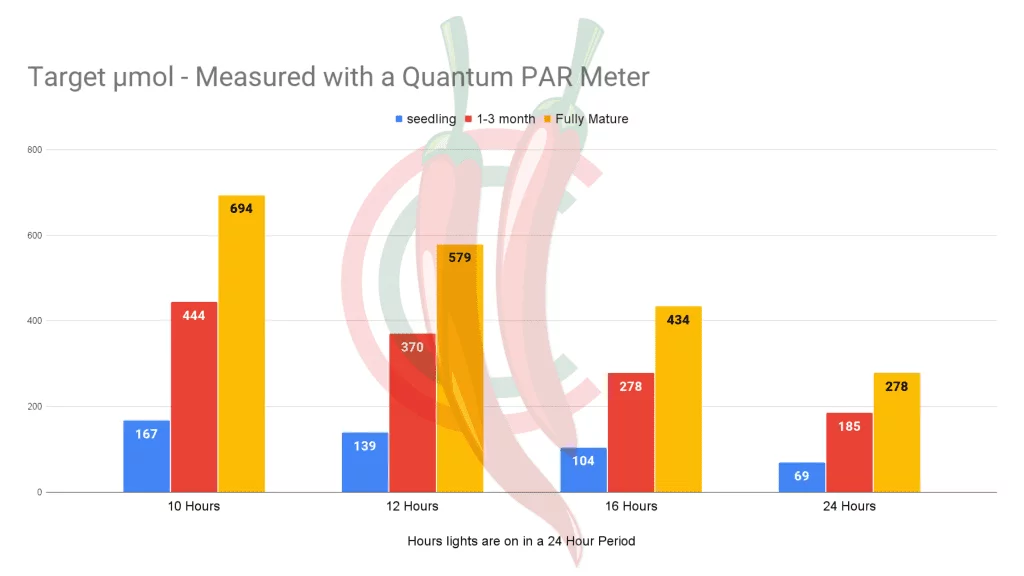
This may mean adjusting your light fixtures from a low light level to a high light level during the various stages of growth.
As I mentioned, PAR meters are expensive, but if you’re using a modern, full-spectrum LED grow light, then the graph below may help:
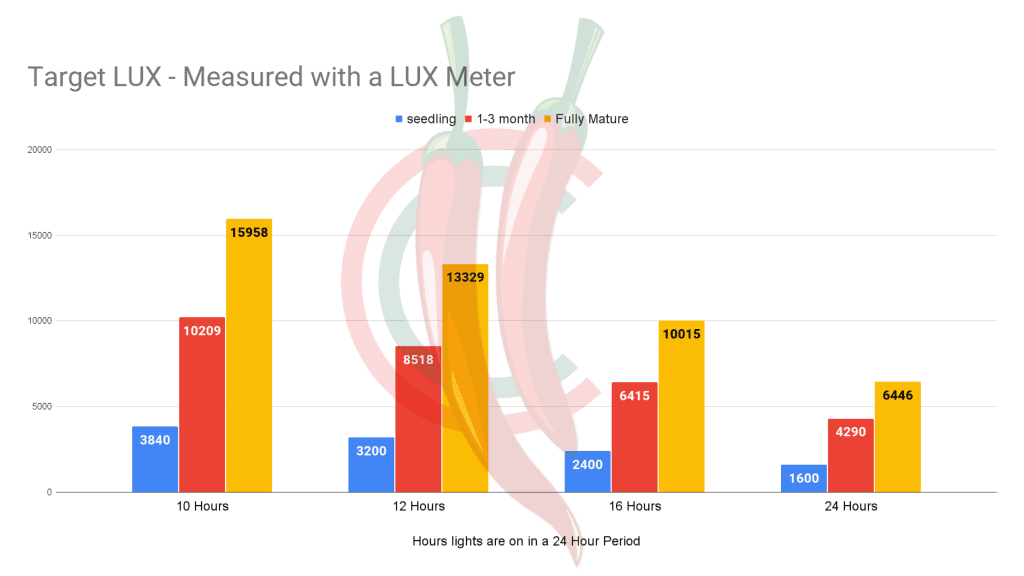
PAR vs LUX
I correlated readings from a cheap Lux meter and PAR meter readings. If you get a cheap Lux meter, these measurements will help indicate the desired light levels. Remember, the recommendations in the graphs above are a safe starting point. Feel free to increase your light output, but do it gradually over a few days and monitor your plants’ health.
Below are a couple of links to PAR and LUX photographic light meters I would recommend if you’re keen to monitor your growing environment closely:
- LUX Meter: https://geni.us/unitlux
- MQ500 PAR Meter: https://geni.us/mq500
- SQ520 PAR Meter: https://geni.us/sq520
Your plants will tell you if they’re not getting enough light, they’ll start reaching to try to get more light and become unhealthy and weak.
Equally, if they get too much light per square foot, you’ll see signs of bleaching, curling up, darkening, or even burning of the leaves. Take care not to give your plants too much light, as you’ll end up with an unhealthy plant, and it may even die.
Adjust the brightness of your light until you get the readings you need based on your plant’s growth stage. If you can’t adjust the brightness of your lights, move them closer or further away from the canopy of your plants. Light intensity follows the inverse square law, meaning if you double the distance of your lights from your canopy, it reduces the light to a quarter of its intensity.
If you want more details on light measurements, then watch this dedicated youtube video:
Artificial Lights for Plants – When Should I Stop Using Artificial Lights to Grow Plants?
The ultimate light for plants is natural sunlight, so you should stop using artificial grow lights as soon as you can get your plants outside safely. Your seedlings should be strong and healthy, and you’ve seen the last winter frosts.
Introduce your seedlings to the great outdoors in stages. Move them outside for a few hours daily, steadily introducing them to sunlight to harden them off. You can increase how long you leave them outside over time.
Be sure to put your plants back under the grow lights when you move them back inside. If you stop using the grow lights, your plants will again start reaching for the light, and you’ll risk them getting leggy and weak.
You are ideally, moving your plants outside a couple of weeks after the last frost would be best. The last thing you want is the frost to kill off your seedlings and ruin your season completely. Waiting until the right time will help your plants to flower, and your flowering plants will also deliver earlier and larger harvests.
Of course, if you have no or limited outdoor space, you may need to use your grow lights for longer or all year round.
Conclusion to Artificial Grow Lights: Boost your Plant Growth
So, if you’re keen to start growing your crops, growing in challenging conditions, or looking to improve your harvests, artificial grow lights can help you get started.
Care for your plants as they grow, adjusting the light, water, and nutrients they need to give you the ultimate rewards.
If you found this article helpful, consider subscribing to alerts when new articles are published. Alternatively, watch my Beginners Guide to Growing Chilies, which includes information on grow lights and more.
Artificial Grow Lights: Boost your Plant Growth – FAQs
What Can I Do to Ensure My Plants Recieve Enough Light in the Winter?
You’re in the right place. In the article above, we discuss the use of supplemental light during winter months or low light indoor locations. Investing in one of these grow lamps and a light meter allows you to take complete control over the lighting conditions for your plants throughout the year.
Benefits of Artificial Sunlight for Plants?
Artificial sunlight for plants extends your growing season if you have limited light during certain months. They allow you to grow a broader range of plants indoors with limited outdoor space. And they give you so much more control over your growing environment.
What’s the Best Artificial Light for Plants Indoors?
I’d love to be able to give you a list of the 10 best lights for gardeners; my list is a little shorter than that but will hopefully be helpful:
- LED
- Viparspectra XS1000: https://geni.us/xs1000.
- Spiderfarmer sf1000: https://geni.us/spiderfarmersf1000.
- Marshydro TS3000: https://geni.us/mh_ts_lights (Massive coverage).
- Fluorescent
- 2ft x 4 bulb: https://geni.us/t5maxibright.
- Cheap CFL 24w: https://geni.us/cfl_24w.
- Higher output CFL: https://geni.us/t5_105w.
Subscribe to our newsletter!

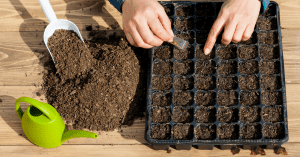
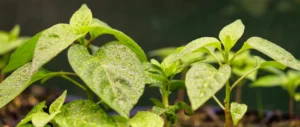


Thank you! I have noticed that most grow light bulbs only shine in one direction, with half the bulb obscured by a cover or something. I’m wondering if I could put a grow light into a floor lamp with a drum shade as long as the plants sit directly below it? The light they would receive would not be filtered through a lampshade, but it would be light reflected down by the lampshade, since the light emitted from the bulb would be directed upwards. Is reflected light from a grow light bulb sufficient for growing plants?
Great article! Thank you! I’m using the Viparspectra XS1000 for my second chili grow season and I’m really impressed with the results… What would you reccomend for the first few weeks: 25% or 50% output? I have my plants in a grow box and my light is about 40cm away from the canopy. Greetings from Switzerland! :o)
Hi there! Thank you. Your Viparspectra XS1000 puts out a lot of light. You need to turn it down as much as you can, especially at 40cm. The age of your seedlings/plants will also be a factor here.
Hey Sean. Thanks a lot fo your advice! That’s right, the Viparspectra puts out a lot of light… I just adjusted the height to 60cm and dimmed the output down to 25%. My plants are a few weeks old, the first true leafs are just starting to develop. I think, I’ll adjsut the output to 50% as soon as I repot them in bigger pots. Thank you again for your great articles!
Pingback: Starting Chilli Pepper Seeds - Chilli VIP